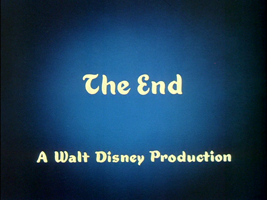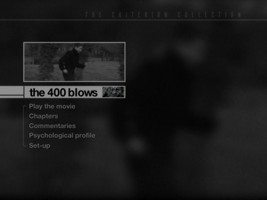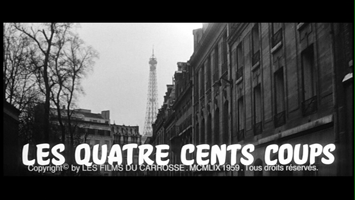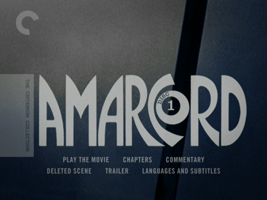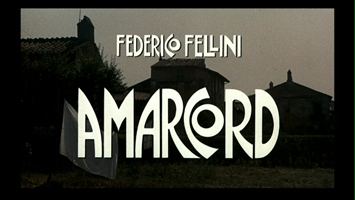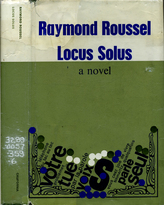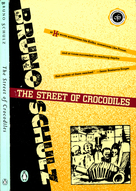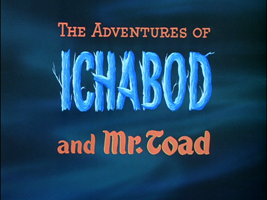
ADAM That was awesome!
BETH That was one of my favorites. But I don’t think Mr. Toad should be shown to children. There’s just no way they could follow it. It was hard even for me. Was that what it was called? Mr. Toad?
BROOM I would say that section is called The Wind in the Willows.
BETH Well, I thought The Wind in the Willows was pretty interesting but not for kids at all.
BROOM I agree. I thought both segments in the movie required a sophistication of narrative comprehension that kids just don’t have. I remembered seeing both halves, separately, and not being able to really follow either of them. As a kid watching the Sleepy Hollow section, you don’t know what’s going on… and then eventually there’s the headless horseman at the end. And it still seems like a payoff, because it would be a good payoff for any story. But the psychological, interpersonal content is over your head. I think kids would also have a hard time answering the question of what type Ichabod Crane is.
ADAM Namely: a hideous pantywaist. That’s what went through my head the whole time. He’s just this mincing, sly, hook-nosed, homosexual Jew. Well, he’s not really a homosexual Jew, but you know.
BROOM But it’s more complicated than that, because then the question is, why are women into him? What does Katrina Van Tassel see in him? Is she just using him to make Brom jealous? It’s all based on non-standard subtleties of characterization that would never be in a Disney movie today.
ADAM The other women are just desperate mongrels. We’ll see these women again, pursuing the Pirates of the Caribbean.
BROOM And pursuing Gaston in Beauty and the Beast, which borrowed heavily from this.
ADAM Yes. In the first scene, when we saw Ichabod walking down the street with his nose in the book, I kept thinking about Belle’s opening number.
BETH I don’t know Beauty and the Beast.
BROOM Well, you will… in a year.
ADAM Belle, being an untraditional Disney heroine, loves to read, and in the first scene she walks through town with her nose in a book, greeting the villagers, and Gaston tries to get her attention. Gaston being a sort of handsome brute.
BROOM Gaston is exactly the same as the guy in this movie. Except he’s less sympathetic. But that’s another interesting thing about this movie: there are no truly sympathetic characters. Brom Bones is a bully… but you can’t blame him… but you don’t root for him either. Do you?
BETH No.
ADAM I want to put this out there: Brom Bones is the first authentically hot Disney character. Discuss.
BETH I actually had the thought, while watching, that he was nearly as ugly as Ichabod, but in a different way.
BROOM I thought that Katrina was pretty hot.
BETH Did you? She was definitely the fattest yet.
BROOM She was “buxom,” if that’s what you mean.
ADAM She was a blooming rose, and you’re just jealous of her petticoats.
BETH She was buxom but her face was pudgy.
BROOM I didn’t have a problem with that.
BETH She seemed a little stupid-looking, though.
BROOM Smarts don’t really come into it.
ADAM So there have been several attractive ladies, but has there been a hot man?
BROOM Certainly not in the muscled sense.
ADAM Tarzan is hot, we’ll come to see, and Robin Hood is hot.
BROOM Robin Hood is hot in a whole other way.
ADAM Well, he’s a fox.
BROOM He’s like Errol Flynn hot.
ADAM Yeah, whereas this guy was like [my boyfriend] hot. And he’s not really a bad guy.
BETH He’s not a bad guy, but he’s sulky.
BROOM That’s what I’m saying is the odd thing about that story; they wouldn’t make it now because there are no clear heroes and villains. In neither of these stories, in fact.
BETH They wouldn’t make either of these stories now. The first one in particular I just found so inaccessible for kids.
ADAM It’s hard to understand what they’re saying, for one thing.
BETH You have Scottish and British dialects, and the story is about, like, a deed.
ADAM It’s a courtroom drama.
BETH It’s about the ownership of a house.
BROOM Okay, Adam, voice your objection.
ADAM What?
BROOM That the end of Wind in the Willows doesn’t make sense.
ADAM Oh. Well, it’s true that it does not make sense that merely retrieving the deed from Winky would demonstrate Toad’s innocence, let alone that he owns it. It wouldn’t exonerate him. I don’t understand the logical connection there. I must say, I never understood the Wind in the Willows ride – or, I should say, “Mr. Toad’s Wild Ride.”
BROOM It’s based only loosely on the movie. In Mr. Toad’s Wild Ride, you hit a train and go to hell.
BETH Don’t you go up into the sky at some point?
BROOM Well, you hit a henhouse, you break things.
ADAM I knew there was going to be a motorcar in the movie.
BROOM The whole ride is about driving recklessly in a motorcar.
ADAM And there is a cop, and a scene where you escape prison.
BROOM You go to court and a judge slams a gavel, too. And there’s a scene where you drive through Toad Hall and see weasels wrecking everything.
BETH They closed it at Disneyworld. I don’t know if it’s still open at Disneyland.
BROOM But at the end, you escape somehow and you’re on train tracks, and you see the headlight of a train coming directly at you, and there’s a boom, and then you’re in hell and there are devils taunting you. So I wasn’t sure Mr. Toad was going to survive the movie, but he did. But perhaps “you” aren’t Toad himself in that ride.
ADAM Probably fewer than one percent of visitors to Disneyland have actually seen The Adventures of Ichabod and Mr. Toad.
BROOM Oh, I don’t think that’s true. Lots of people have seen this movie.
ADAM I guess maybe just I had not seen it.
BETH I thought I had seen it, but I did not remember it.
ADAM I found it totally charming. It was like a Dickens story.
BROOM I remember knowing, when Who Framed Roger Rabbit? came out, that the weasels in that movie were from something, but I had since forgotten what it was they were from. They were from this.
ADAM It’s like a Dickens story crossed with a Wodehouse story. The courtroom stuff was funny.
BROOM It was all very entertaining. I don’t know why The Wind in the Willows is called that, or why it’s a classic of British literature. Maybe I should read it.
ADAM I’m not sure that it’s a classic of British literature any more than, like, “Johnny Appleseed” is a classic of American literature.
BROOM Well, the narrator of this movie said that he thought that Mr. Toad of Toad Hall was the most fabulous character in English literature.
ADAM But it said that on his script.
BROOM Maybe. Anyway, what I was thinking throughout – besides that the movie had no sympathetic protagonists in either half…
ADAM I think all four of the main characters of Toad are sympathetic.
BROOM You were rooting for them more or less, but you weren’t them. There was no clear hero. Toad was the heroic central figure but you didn’t quite like him. I mean, I liked watching him, but I didn’t identify with him.
BETH He was just a goofball.
BROOM Yes. Adam said in the middle, “he’s kind of an asshole,” and he was.
BETH I said he was like a baby.
BROOM He’s some ideal of aristocratic recklessness that’s supposed to be charming.
ADAM And is.
BROOM Anyway, we’ve been saying that with this movie, now we’re “out of the woods” of these second-rate package features, and in many ways this movie did seem like it initiated a new direction, toward what Disney is now.
ADAM Sophisticated adult jokes and lavish animation for children?
BROOM Actually, I think this movie was markedly more adult than what Disney is now.
ADAM They would never end a story the way Sleepy Hollow ended. Obviously the whole point of the Washington Irving story is that it is ironic, and that he does not explain the ending, although it is pretty clear what happened to Ichabod Crane. But for children – I was expecting at least a wink, like Brom’s head popping up through the cape. But they didn’t give you that.
BROOM I remembered very specifically from childhood that you had to put it together yourself. That was right on the edge of what I was able to do as a kid. But I didn’t really understand what the tensions had been. As a kid you just know, “that guy’s trying to make that guy dance with the fat girl, and now that guy’s outside, and now that guy’s telling a scary story, and now there’s the headless horseman!”
ADAM That’s like every time I watched “Three’s Company.” I was too young to understand that Jack was pretending to be gay so that Mr. Furley would allow him to live with Chrissy and Janet.
BROOM Of course you were too young to understand that.
ADAM But I loved “Three’s Company”! So I don’t know that not understanding adult jokes is a bar to children’s enjoying something.
BROOM I think it was a bar to enjoying parts of this where there’s no slapstick for a while, there’s just a lot of walking. There’s a fair amount of watching characters talking and gesticulating in Wind in the Willows – which I thought was interesting, because we’d talked about how they hadn’t really found a convincing way to animate full-fledged humans yet, and, while these were of course still animals, there was something newly human about the way the dialogue was handled.
ADAM I thought it was very funny that Toad was the size of a toad.
BROOM I thought it was funny that he wasn’t the size of a toad but he wasn’t the size of people either. He lived in a house and was about as tall as the doorknob, which is neither the size of a toad nor the size of a person.
ADAM A toad is smaller than a doorknob?
BROOM No, he wasn’t the size of a doorknob; his head reached to the doorknob.
ADAM But when he was in court, he wasn’t more than the size of a toad.
BROOM The animals were like half a person’s height. They weren’t toad-sized, they were hobbit-sized.
ADAM As a kid, would you have understood that both Angus MacBadger and Scrooge McDuck are Scottish stereotypes of stinginess?
BROOM Of course not. I didn’t even process now that he was a stereotype of stinginess. I just thought that he was a serious-minded older guy.
ADAM Well, he’s an accountant type, which is a Scottish stereotype. Would you have understood that he was Scottish?
BROOM I don’t think I even knew that was a Scottish stereotype. To be an accountant?
ADAM Well, not an accountant, but to be concerned with penny-pinching.
BROOM Only Scrooge McDuck. I don’t know it outside of these cartoons. Can you give another example?
ADAM I’ll have to look into it.
BROOM Well, I wouldn’t have gotten that.
BETH You wouldn’t have gotten that he was Scottish?
BROOM Probably not. As a kid?
BETH How old are we? If I was six, no. If I was nine, yes.
BROOM Really? I might have recognized that they were the same thing as each other – I think we’ve had this conversation before.
ADAM I thought it was unpleasant that Ichabod Crane wanted her money. It was kind of clear that he was not sexually interested in her. He’s kind of a weirdo for that reason.
BROOM He was both sexually interested in her and interested in her money, and they emphasized the money to drive home that there was nothing sympathetic about this, and that we should side with the bully. Which was a weird case for a movie to make. Ichabod was just a very strange character all around, and that was the point of the movie, and that was odd for Disney. And the character design, with no chin and a big ugly nose and huge ears, was weird and interesting. And I think it answers – earlier than I predicted last time when we talked about this – our question of “when will they create a person who has distinctive person-like characteristics.” We were complaining about the bland-faced people in Melody Time. You definitely knew exactly what Ichabod’s head looked like, in three dimensions. The human animation was really full of character, and they still looked like people, so I think they achieved what we were talking about. But there’s still room for improvement. But what I was going to say earlier: I felt like this was the first movie where the storyboard work, and the pacing and plotting, felt really sturdy and familiar.
ADAM None of us came close to falling asleep, and I was sorry when Mr. Toad ended.
BROOM I’m glad. I didn’t know what you guys were thinking. I’ve been enjoying the other ones, and then it turns out that you guys didn’t like them. And I was enjoying this one too but I thought, “maybe they’re going to say this is dumb, I don’t know.”
ADAM No, it was good. But it was a little jarring to leave Mr. Toad in his airplane and then suddenly we’re with Bing Crosby in a library. They gotta fix that.
BROOM Well, this will be the last movie where something gives way to something else that has nothing to do with it.
BETH I agree with what you’re saying about the plotting, and I thought, “how refreshing that we’re actually watching stories, here, being told well.” Especially when you think about “Bongo.” It’s a big contrast.
BROOM Well, I think both parts of Fun and Fancy Free – “Bongo” and “Mickey and the Beanstalk” – were had-been-aborted-and-then-were-quickly-wrapped-up projects, and they didn’t represent the full force of the studio.
ADAM Is it relevant that Mr. Disney didn’t come up with these stories, but that they’re adaptations?
BETH I thought it might be relevant. But just that they can take something and tell it well is the big improvement. [ed. worth reminding ourselves that apart from stuff like “Pedro the Mail Plane,” none of the movies so far have been on original stories]
BROOM There’s definitely a different thrust to this from their earlier successes, than Pinocchio or even Snow White. This feels like a more conservative, less visually-oriented type of storytelling. It’s more like normal movie-making. It just had a different rhythm to it, and I felt like, “Oh yeah, this is how Disney movies flow.” Strong caricatures are used to send clear signals to a kid about what each scene is. During the heist scene where they’re lowering him down on a rope, I was thinking that not only is this scene familiar because it’s used all the time, but it’s been set up very purely, so it’s clear exactly what the standard tensions are. I’m not sure how to say this.
ADAM Like… whether the person falls or not?
BROOM Just what the significance of the scene is, and what’s at stake. Like, what kind of function it serves in the plot, and also in itself. It telegraphs its own function and mechanism in such an immediate way.
ADAM What’s the earliest movie where you remember it being a plot device that someone is trying to retrieve something from somebody sleeping, and the sleeping person ends up hugging the would-be thief as if he were a pillow?
BROOM This goes back to the “meme-o-pedia” idea I’ve mentioned several times. There’s “trying to retrieve something from a room full of sleeping people,” “trying to retrieve something from a person holding it while sleeping,” and then as a subcategory of that, what the person does when it doesn’t quite go right. Hugging is one of the several options; there’s also rolling over and putting it where it can’t be gotten; there’s the “they can only get it when they’re yawning” gag, where someone has to tickle their nose with something to make them let it go. A lot of options there. This one had the hugging.
ADAM And the tickling.
BROOM Did it?
ADAM That’s how he freed himself.
BROOM I guess I must have seen that and been thinking of it, but just now when I said it, I thought I was coming up with it out of nowhere.
ADAM I liked that this was not yet in the Disney mold of, like, a spunky hero on a voyage of self-discovery.
BROOM When we started this project I thought we would get to watch the evolution of that very formula. And what I’m saying is that I think this is the first time we’re really seeing a definite step in the process of that evolution. Somehow everything before this had a different emphasis. There’s some kind of divide, during the war, where there’s not a completely direct relationship in style between what precedes and what comes after. Then again, maybe there is. But I felt like here they suddenly have maybe fifty percent of the elements of the Disney movie “brand” in place.
ADAM Well, Pinocchio is in that mold, sort of.
BROOM It’s a quest, but it’s episodic, as we talked about then. It doesn’t quite have that feeling of an outline with sections like “Introduction to characters”; “First stage of conflict”; “Second stage of conflict”; “Climax.” It just has a bunch of linked episodes. This felt very cozy, like we were now in the hands of something very familiar, even though I didn’t remember the details of these particular movies. Just the way it worked was comforting and traditional.
BETH I still think that for these to be the first two stories that they tell as regular stories in ten years was a strange choice.
ADAM Well, these are the two most fabulous characters. They had no choice.
BETH So was this a success?
BROOM Yeah.
BETH It was?
ADAM Oh, you mean commercially?
BETH Yes, commercially.
BROOM I don’t know. It’s hard to find out that information for older movies. We can find out what the Times review said; we’ll read that in a second. Any thoughts about the songs?
ADAM They were out of place.
BROOM I thought it was pretty hilarious when I first saw that they sing a swingy song at the beginning on the phrase “Ichabod and Mr. Toad.” A title song justifying this meaningless assemblage. And then you guys chuckled when they started singing the “Ichabod Crane” song. I think they knew it was a little funny. I think part of the joke was, like, “We got Bing Crosby and we’re gonna use him.”
BETH They were out of place but they weren’t bad, so I didn’t mind them.
BROOM I think that “Merrily Merrily Merrily Going Nowhere In Particular” was pretty bad.
BETH I forgot about that. The ones in the Ichabod story weren’t so bad.
ADAM The ones in the Ichabod story jarred with the colonial American tone.
BETH I was thinking, “He’s not only telling them a ghost story, he’s introducing them to a whole new form of popular music!”
BROOM I think as a kid that stuff all just mixed together for me, because it was all “out of the past.” It was just cozy stuff your grandma might like. Your grandma might have a sampler in her house and she might listen to Bing Crosby.
ADAM Did you find it a comforting idea that a nerd could dance well and almost get the girl?
BROOM That’s what was so weird about it. He wasn’t just a nerd.
ADAM He was a conniving, mean nerd.
BROOM He was talented, and elegant and graceful, and also obsessed with eating sweets when people weren’t looking.
BETH Eating anything! Whole turkeys.
BROOM Manipulating people so that he could get to their turkeys. And yet he also was an idiot.
BETH And he had a lovely singing voice.
BROOM “Ba ba ba boo!” Did Bing Crosby actually sing “ba ba ba boo?” Why was that his thing? What was the context where he would sing “ba ba ba boo?” At the beginning, when the credit came up that said “Bing Crosby,” they gave him a little vocal solo to go “ba ba ba boo!” to signify “Bing Crosby is singing!”
BETH I don’t know.
BROOM Back to what I was saying before: there was a lot more acting in the facial animation. Not just vaudeville slapstick acting, but actual the-way-people-would-act acting.
ADAM Furrowing brows.
BROOM Yeah, all sorts of sophisticated expressions. Like when Ichabod looks in the mirror and thinks “you sly devil,” and he has a funny little crinkled mouth and makes faces at himself, I thought that was a new level of sophistication in what they got into the character’s face. And also when Mr. Toad was going on about his various passions, and being Mr. Toad, he did all kinds of well-characterized stuff.
BETH I liked Mr. Toad’s faces.
BROOM The quality of the acting was at a higher level, and the emphasis on acting was greater.
ADAM Mr. Toad is no one you’d want to hang out with, but he was a charmer.
BROOM “He had many fair-weather friends.”
ADAM Do we think this is one story plucked from a long series of stories in The Wind in the Willows? It seemed to start mid-stream, as if they had just picked out a single story.
BROOM I don’t know what happens in The Wind in the Willows. There might be more to it. [ed. seems like this is the main storyline, streamlined and tweaked]
BETH Sequences that I liked a lot were: the train chase with all the cops shooting at Mr. Toad, and the dance sequence with the fat girl, which I thought was hilarious.
ADAM I liked the courtroom fun.
BROOM I liked the parts Beth liked; I also liked the stuff with the weasels; I thought they had a good look to them. And I thought the spooky sequence at the end was good – the whole thing builds up to it, and it’s very satisfying.
ADAM Although the animation of the headless horseman looked a little too much like a He-Man cartoon.
BROOM I thought that was what was cool about it. Ichabod Crane, looking the way he’s looked for the whole movie, is riding right next to him, and the headless horseman nonetheless is animated in this different style, to make him unearthly. I really liked the first shot, when the camera whips over and you suddenly see The Headless Horseman, rearing up perfectly, and the background goes red. I enjoyed that. But what about the animation and design in general? There was less of an emphasis on…
BETH …lushness?
BROOM On draftsmanship.
ADAM There were no whirling leaves anywhere. [ed. actually, there are a couple, when Ichabod looks up at the moon]
BETH I thought the trees in “Sleepy Hollow” weren’t so great looking. I liked that they were flat, but otherwise I didn’t like the style of the drawings.
BROOM I thought a lot of the artwork was more utilitarian than previously.
BETH Serviceable.
BROOM Yes, serviceable. There wasn’t nearly as much design enthusiasm as in the music movies.
BETH Which is fine.
ADAM Well, wait ’til Rapunzel comes out.
BROOM Right, in the style of Fragonard.
[we read the rather pedestrian Times review, by one “A.W.” Link below.]
ADAM I miss Bosley.
BROOM I had another thought but I can’t remember it.
ADAM Why wasn’t Cyril upset about losing his job to a motorcar?
BROOM Ah, now I remember: anything to say about the undertones of homosexuality throughout this film, Adam?
ADAM What do you mean? Between whom?
BROOM Well, between Mr. Toad and Cyril, and between Water Rat and Mole.
ADAM Water Rat and Mole had just a sort of English ladies’ domesticity to them. Which I didn’t take to be homosexual.
BETH Didn’t Mole have a crush on Mr. Toad?
ADAM Well, didn’t you?
BROOM I thought he just had a charisma crush on him, yeah.
BETH All right, fine.
ADAM And I thought Cyril and Mr. Toad were just, you know, fellow rabble-rousers. Cyril is like a Cockney brawler. I found this movie remarkably free of homosexual undertones.
BROOM Oh. When he was jumping on the horse’s butt and shouting “I won’t get tired of this!” I thought you were laughing.
ADAM Oh, no, it didn’t even occur to me. I just thought they were sort of, you know, the Rat Pack. You know, in rural England. At most, Rat and Mole were like Bert and Ernie. They’re just friends. What a sicko you are.
BROOM I really thought that Mr. Toad had that fey quality and his enthusiasm seemed primarily to be to jump on Cyril’s butt, and I thought you were laughing at that and would want to say something about it.
ADAM No. He did have a vaguely Oscar Wilde-ean quality.
BROOM Yes, exactly. He had limp wrists! He was the first limp-wristed character we’ve seen.
ADAM But he was sort of a wit, you know, and like a…
BROOM …bon vivant?
ADAM Yes. I didn’t take him as coded gay, per se.
BROOM Well, no. But something. And then Winky…
ADAM Yeah.
BROOM Okay, fine, so there were no gay characters in this movie. Thanks for watching, guys. Next time: Cinderella.
BETH Wow.
ADAM A hotbed of gay themes.
